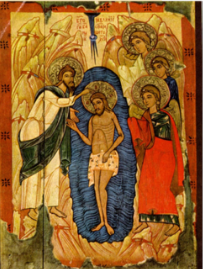SACRAMENT

The term SACRAMENT (from the Latin sacramentum, meaning "a consecrated thing or act," l.e., "something holy," "to consecrate;" which itself was a Church Latin translation of the Greek mysterion, meaning "mystery"). In every SACRAMENT or HOLY MYSTREY there is a combination of an outward visible sign with an inward spiritual grace. Saint John Chrysostom wrote that they are called mysteries because what we believe is not the same as what we see; istead, we see one thing and believe another. Generally, the Church recognizes and counts seven (though not only seven) mystries: Baptism; Chrismation; Eucharist; Confession; Holy Unction; Marriage and Ordination. The more ancient and traditional practice is not to isolate these seven from the many other actions in the Church which also possess a sacramental character (such as the service for the burial of the dead, the rite for a monastic profession and the blessing of waters at Epiphany). Even the blessings of homes, fields, cars, and pets have a sacramental nature.
SACREMENT
Le terme SACREMENT (du latin sacrament, qui signifie «chose ou acte consacré», et désigne «quelque chose de saint», «de consacré»; le mot latin est lui-même la traduction du grec: mysterion signifiant «mystère»). Les SAINTS MISTÈRES ou SACREMENTS sont des cérémonies traditionnelles et sacrées, instituées par le Christ ou par ses apôtres, grâce auxquels, par des signes visibles, la grâce divine et invisible nous est transmise. Ce sont les moyens de la participation mystique à la grâce divine pour le salut de l'humanité. dans un sens général, l'Église reconnaît et compte sept (mais pas seulement sept) mystères: le Baptême; la Chrismation; l'Eucharistie; la Confession; la Sainte Onction; le Mariage et l'Ordination. Toutefois, il ne faut pas isoler ces sept sacrements des nombreuses autres actions dans l'Église, qui elles aussi possèdent un caractère sacrementel (comme l'office funèbre, le rites monastiques et la bénédiction des eaux lrs de l'Épiphanie).